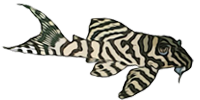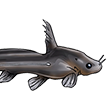Can you ID these Plecs
- Acanthicus
- Posts: 870
- Joined: 24 Jan 2011, 14:32
- My articles: 5
- My images: 92
- My cats species list: 29 (i:0, k:0)
- Spotted: 80
- Location 1: Kiel
- Location 2: Germany
- Contact:
Re: Can you ID these Plecs
Hi
Check L 66 and L 333 for comparison, surely a Hypancistrus and one of the wormline-complex too. They are similar in their requirements, so the actual variety/l-number isn't a big matter. Make sure they are not getting mixed with any other "similar looking" or "surely the same species" specimens to prevent an untraceable process of hybridization.
Check L 66 and L 333 for comparison, surely a Hypancistrus and one of the wormline-complex too. They are similar in their requirements, so the actual variety/l-number isn't a big matter. Make sure they are not getting mixed with any other "similar looking" or "surely the same species" specimens to prevent an untraceable process of hybridization.
Daniel
-
jdt28
- Posts: 6
- Joined: 09 Aug 2015, 22:28
- My cats species list: 1 (i:0, k:0)
- Spotted: 1
- Location 1: UK
- Location 2: ENGLAND
Re: Can you ID these Plecs
Thanks for your input Daniel.....These were actually given to him as L236 Basic but as always there is a little doubt when identifying stripey Hypans
- TwoTankAmin
- Posts: 1504
- Joined: 24 Apr 2008, 23:26
- I've donated: $4438.00!
- My cats species list: 6 (i:0, k:0)
- My BLogs: 2 (i:0, p:30)
- Location 1: USA
- Location 2: Mt. Kisco, NY
- Interests: Fish and Poker
Re: Can you ID these Plecs
I have two breeding groups of L236, I can offer the followings personal opinions:
1. I do not believe it will ever be formally identified. I think it is basically a natural hybrid.
2. As a result of #1, I find this fish to be highly variable in appearance.
3. The variability applies to different fish considered to be L236 even when they come from the same parents.
4. The variability also applies to each single specimen as it grows from free swimming to old age. Let's assume one took several babies and put them into different isolated sections of the same tank and took pictures of each fish at 3 to 6 months intervals over 5 years. Then one prints all of the pictures and shuffles them. There is almost no way anyone could reconstruct the individual series correctly. They change too much and not in a predictable fashion.
The above actually bodes well for the pictured fish being 236 regulars. I am also not a fan of the classification of regulars or Grade A. This refers to the specific pattern on any one fish. One of my groups traces back to Robert Budrovcan the other to a now dead breeder in Europe who created a line of super white 236. Both groups have some plain lookers and both have some spectacular lookers.
Caveat emptor.
1. I do not believe it will ever be formally identified. I think it is basically a natural hybrid.
2. As a result of #1, I find this fish to be highly variable in appearance.
3. The variability applies to different fish considered to be L236 even when they come from the same parents.
4. The variability also applies to each single specimen as it grows from free swimming to old age. Let's assume one took several babies and put them into different isolated sections of the same tank and took pictures of each fish at 3 to 6 months intervals over 5 years. Then one prints all of the pictures and shuffles them. There is almost no way anyone could reconstruct the individual series correctly. They change too much and not in a predictable fashion.
The above actually bodes well for the pictured fish being 236 regulars. I am also not a fan of the classification of regulars or Grade A. This refers to the specific pattern on any one fish. One of my groups traces back to Robert Budrovcan the other to a now dead breeder in Europe who created a line of super white 236. Both groups have some plain lookers and both have some spectacular lookers.
Caveat emptor.
“No one has ever become poor by giving.” Anonymous
“Everyone is entitled to his own opinion, but not to his own facts.”" Daniel Patrick Moynihan
"The good thing about science is that it’s true whether or not you believe in it." Neil DeGrasse Tyson
“Everyone is entitled to his own opinion, but not to his own facts.”" Daniel Patrick Moynihan
"The good thing about science is that it’s true whether or not you believe in it." Neil DeGrasse Tyson




